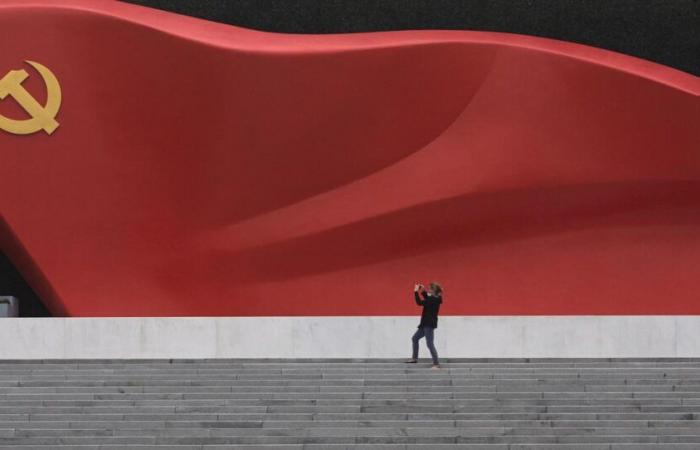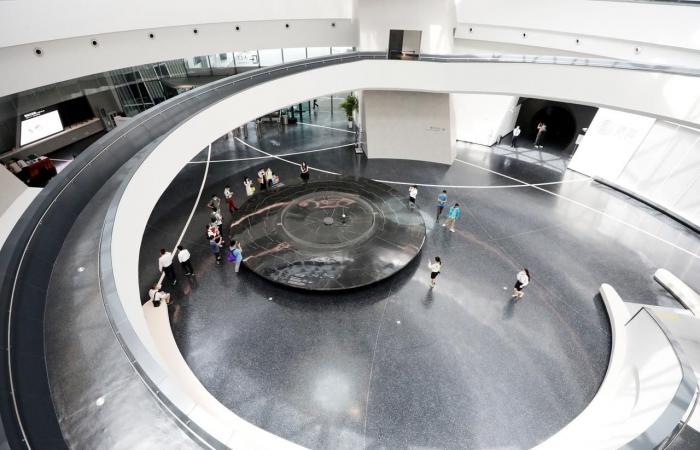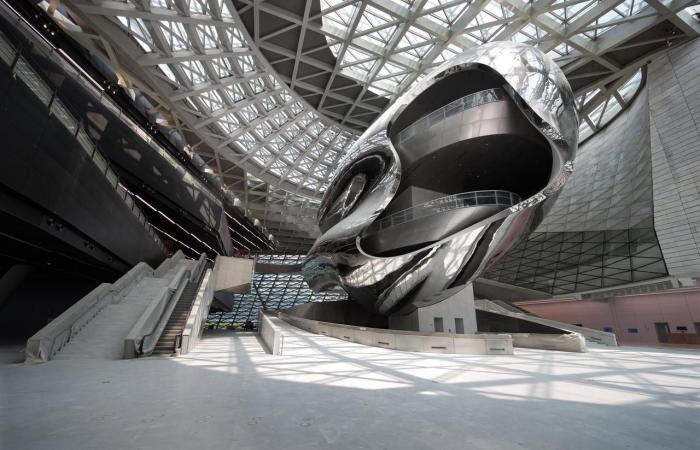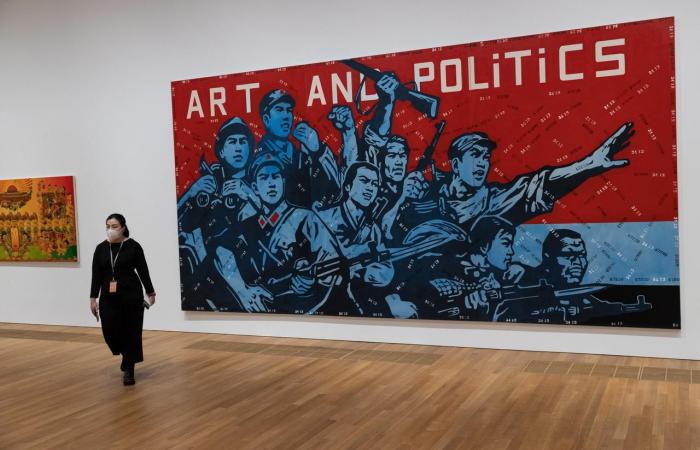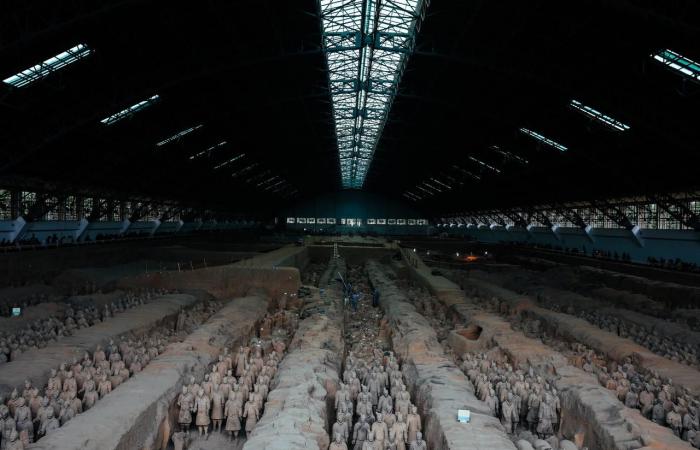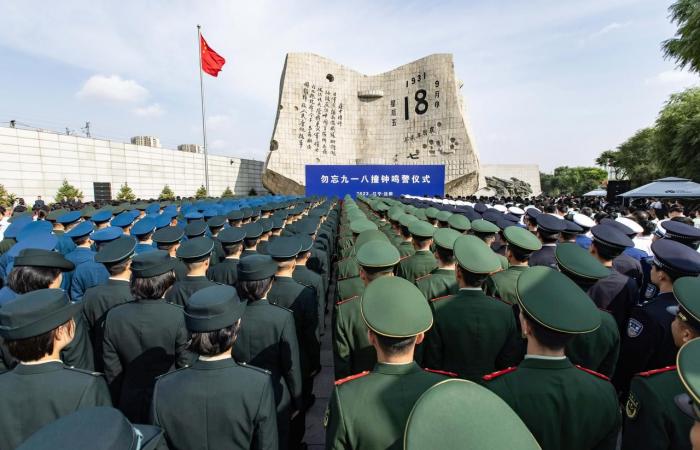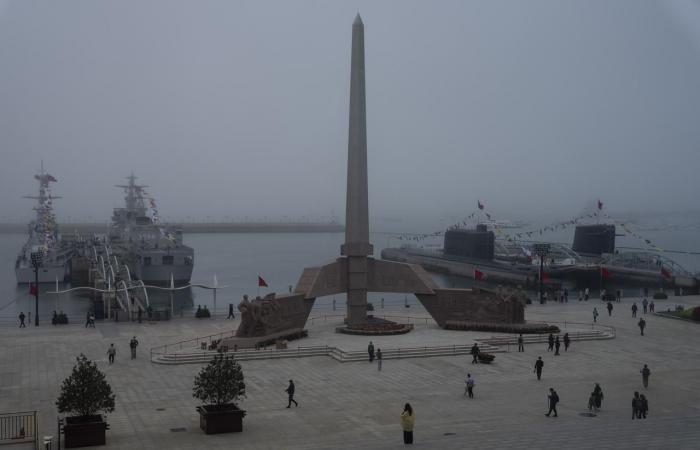China wants to catch up with the world’s cultural leaders and is building museums one after the other, at a rate of almost one per day. Among them, the Shanghai Astronomy Museum, which attracts crowds. Report from German-speaking public television SRF.
It is a museum of all superlatives. The Shanghai Astronomy Museum, which opened in 2021, is the largest museum of its kind in the world and has a unique shape. The main building does not have straight lines or right angles, but consists of several overlapping arches.
“Even at first glance, it should be clear that this is astronomy,” says Lin Qing. The official supervised the construction of the building and heads the research center of the astronomy museum: “Seen from above, it looks like celestial bodies in orbit.”
External content
This external content cannot be displayed because it may collect personal data. To view this content you must authorize the category Services Tiers.
Accept More info
The astronomy museum attracts crowds
The crowds are enormous. Three years after its opening, more than a million people visit the museum each year. Wendy Tao is waiting in line outside the museum. She and her son came from the neighboring province. “We tried to buy a ticket online for three days, without success. Now we try directly at the ticket office.”
![Covering an area of approximately 58,600 square meters, the museum is a branch of the Shanghai Science and Technology Museum. [Xinhua via AFP - FANG ZHE] Covering an area of approximately 58,600 square meters, the museum is a branch of the Shanghai Science and Technology Museum. [Xinhua via AFP - FANG ZHE]](https://euro.dayfr.com/content/uploads/2024/10/19/fcccde0d63.jpg)
However, museums do not have a long tradition in China. In 1978, the People’s Republic had only 349 exhibition halls. Only in recent decades, after the country became increasingly open, did museum construction begin to boom. 10 years ago, it already had 4,000. Today, a new museum opens almost every day and the country has 6,833.
![The Museum of Contemporary Art & Planning Exhibition in Shenzhen, China. The museum complex in the megacity north of Hong Kong opened in 2016. [KEYSTONE - SZETO WING] The Museum of Contemporary Art & Planning Exhibition in Shenzhen, China. The museum complex in the megacity north of Hong Kong opened in 2016. [KEYSTONE - SZETO WING]](https://euro.dayfr.com/content/uploads/2024/10/19/25a933d0ab.jpg)

China wants 15 world-class museums
Despite the growth of museums, their number is lower than the international average. The United States has around 35,000 and Switzerland, even tiny, 1,000. “We need even more museums,” said Liu Jian, president of the astronomy museum. “The history of a country as important as ours must be made accessible to the public through museums.”
![A woman walks past paintings on display at the M+ Museum in Hong Kong, China, November 11, 2021. The M+ Museum, located in the West Kowloon cultural district, opened on November 12, 2021, after years of delays. [KEYSTONE - JEROME FAVRE] A woman walks past paintings on display at the M+ Museum in Hong Kong, China, November 11, 2021. The M+ Museum, located in the West Kowloon cultural district, opened on November 12, 2021, after years of delays. [KEYSTONE - JEROME FAVRE]](https://euro.dayfr.com/content/uploads/2024/10/19/c4a53de563.jpg)
The museum boom is encouraged at the highest level. And it’s not just about quantity: the new museums also aim to achieve international recognition. China should officially have 15 world-class museums by 2035, according to a government plan.
![Terracotta warriors and horses stand in partially unearthed pits at the Qin Terracotta Warriors and Horses Museum in Xi'an, capital of China's Shaanxi province, September 26, 2018. The army of Terracotta is a form of funerary art that was buried to accompany China's first emperor, Qin Shi Huang, in 210-209 BCE, as a guardian of the afterlife. Archaeologists estimate that the three pits could contain around 8,000 figurines. The site was classified by UNESCO in 1987 as one of the world cultural heritage sites. [KEYSTONE - ROMAN PILIPEY] Terracotta warriors and horses stand in partially unearthed pits at the Qin Terracotta Warriors and Horses Museum in Xi'an, capital of China's Shaanxi province, September 26, 2018. The army of Terracotta is a form of funerary art that was buried to accompany China's first emperor, Qin Shi Huang, in 210-209 BCE, as a guardian of the afterlife. Archaeologists estimate that the three pits could contain around 8,000 figurines. The site was listed by UNESCO in 1987 as one of the world's cultural heritage sites. [KEYSTONE - ROMAN PILIPEY]](https://euro.dayfr.com/content/uploads/2024/10/19/dd799fc87f.jpg)
Museums as a platform for state self-promotion
Many newly built museums are therefore superlative museums and, like the astronomy museum, impress with their architecture. The roof of the Luoyang History Museum, which opened in 2022, is reminiscent of a bamboo forest and the Chengdu Science Fiction Museum, which opened last year, resembles a space station.
![People attend a commemoration ceremony for the Mukden Incident at the September 18 History Museum in Shenyang, Liaoning province, China, 18 September 2023. On September 18, 1931, an explosion destroyed part of a Japanese-owned railway near the town of Mukden (Shenyang), which prompted the Japanese army to enter Manchuria. [KEYSTONE - XINHUA / CHEN SONG] People attend a commemoration ceremony for the Mukden Incident at the September 18 History Museum in Shenyang, Liaoning province, China, 18 September 2023. On September 18, 1931, an explosion destroyed part of a Japanese-owned railway near the town of Mukden (Shenyang), which prompted the Japanese army to enter Manchuria. [KEYSTONE - XINHUA / CHEN SONG]](https://euro.dayfr.com/content/uploads/2024/10/19/167e93588d.jpg)
![Visitors view retired warships and submarines at the Chinese People's Liberation Army Naval Museum in Qingdao, east China's Shandong Province, Tuesday, April 23, 2024. [KEYSTONE - NG HAN GUAN] Visitors view retired warships and submarines at the Chinese People's Liberation Army Naval Museum in Qingdao, east China's Shandong Province, Tuesday, April 23, 2024. [KEYSTONE - NG HAN GUAN]](https://euro.dayfr.com/content/uploads/2024/10/19/4d4b949018.jpg)
However, the museum offensive is not limited to the transmission of knowledge. For Beijing, they are also a platform for state expression. They are status symbols and an expression of new self-confidence. The objective is to show, both internally and externally, that the country is not only an economic and political power, but also a cultural power.
Claudia Stahel, SRF 1, Tagesschau, October 9, 2024, 7:30 p.m
French adaptation: Julien Furrer (RTS)

